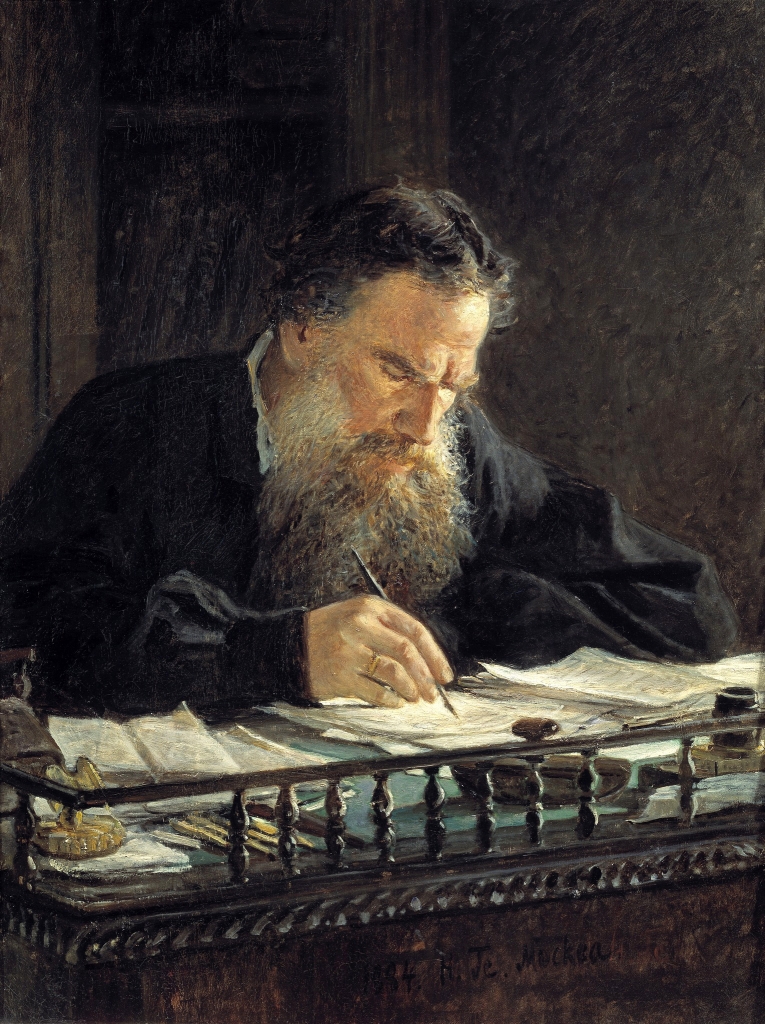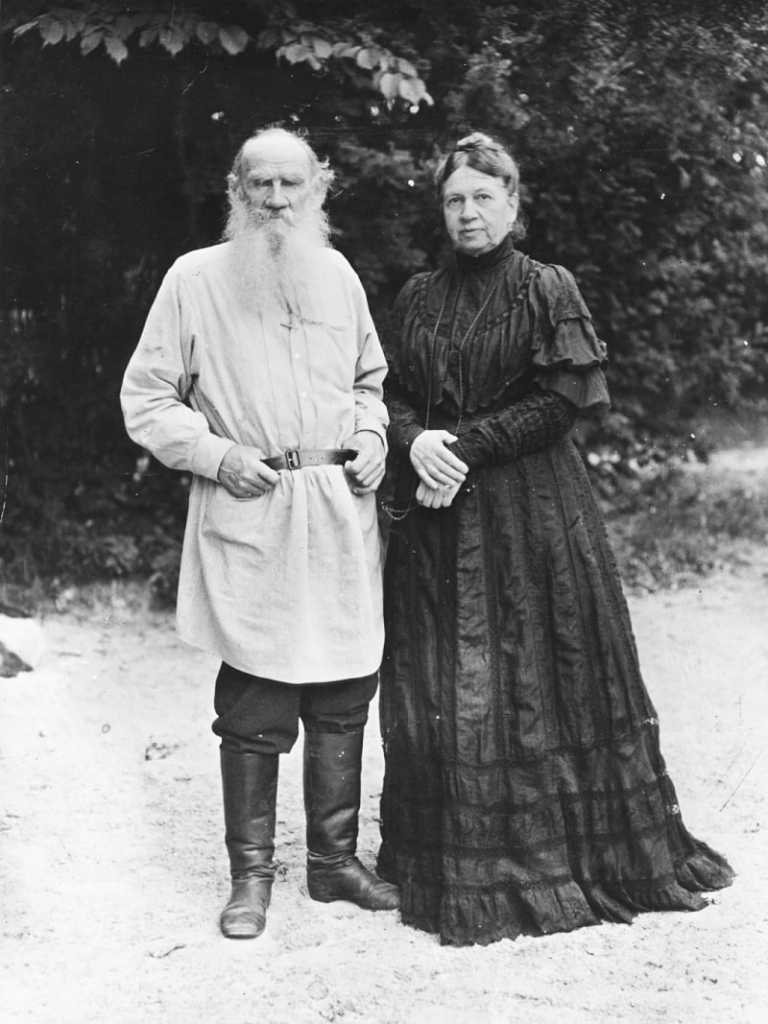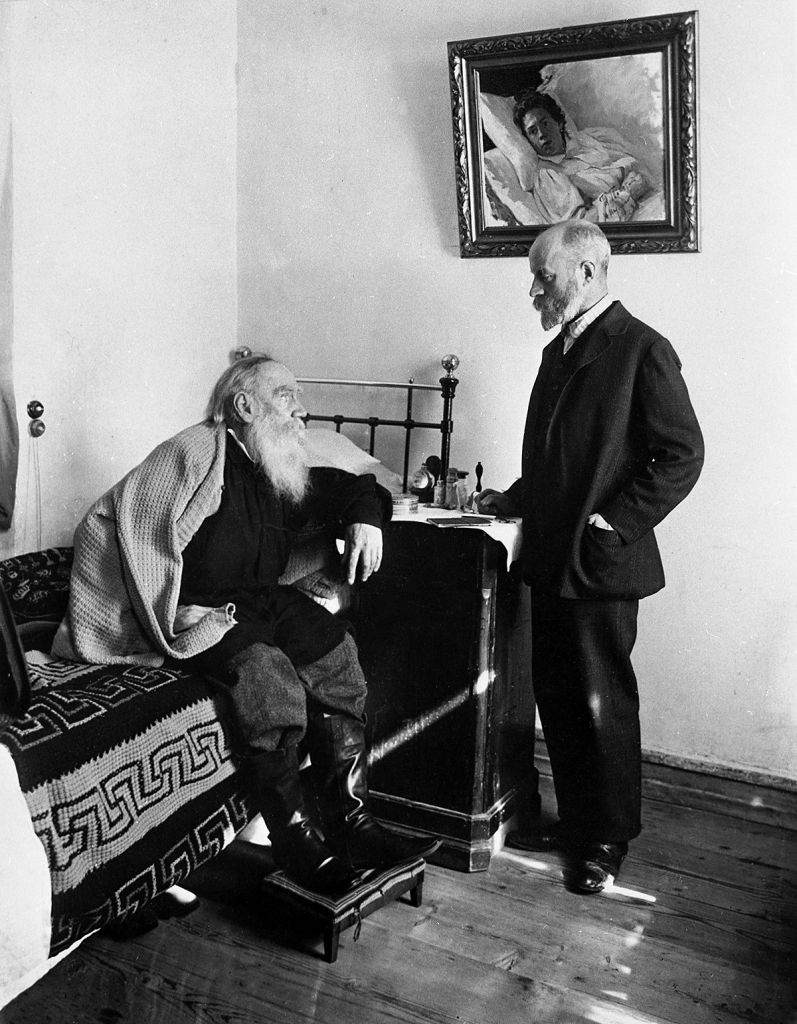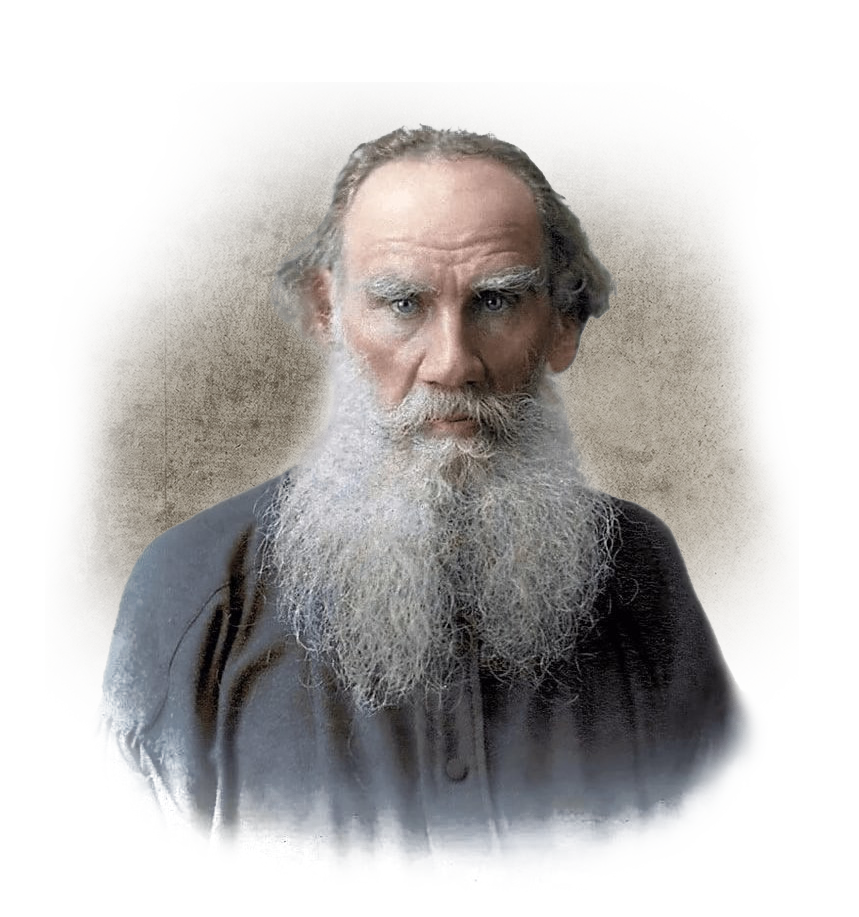Biography
Date and place of birth: August 28, 1828, Yasnaya Polyana, Tula province
Date and place of death: November 7, 1910, Astapovo station, Ryazan province
Occupation: prose writer, publicist, teacher, philosopher, writer, playwright.
Movement: realism.
Genre: short story, novel, drama
Years of oeuvre: 1847-1910
Leo Tolstoy – Russian writer and thinker, participated in the defense of Sevastopol, was engaged in educational and journalistic activities. He was at the origins of Tolstoyism, a new religious movement.
Childhood and Youth
Leo Tolstoy was born on August 28, 1828, on his mother’s birthplace, Yasnaya Polyana, in Tula province. His father was Count Nikolai Tolstoy, a descendant of the ancient family of the Tolstoys, who were in the service of Ivan the Terrible and Peter the Great. His mother belonged to the Volkonsky family, descendants of the Ruriks. Leo Tolstoy and the poet Alexander Pushkin had a common ancestor, Ivan Golovin, admiral of the tsarist navy.
Lev’s mother died shortly after giving birth to her daughter, and Lev was not even two years old at the time. Lev was the fourth child in a noble family. His father did not outlive his mother by much; he died seven years after her death.
The children were orphaned, and their upbringing was undertaken by their aunt, T.A. Ergolskaya. After some time, the duties of guardian passed to a second aunt – A.M. Osten-Saken, who had the title of Count. When she died, the children settled in Kazan in the family of their father’s sister P.I.Yushkova, who became their new guardian. It was 1840. Auntie had a great influence on Leo Tolstoy, the years spent with her, he called the happiest period of his life. Her house was always full of guests, it was considered the most hospitable and cheerful in Kazan. Childhood impressions of living in this family are reflected in his work “Childhood”.



Leo Tolstoy passed the elementary school program at home. He was taught by French and German teachers. In 1843, Tolstoy became a student in the Faculty of Oriental Languages at Kazan University. He was not particularly interested in languages, so his grades were very low. This was an incentive to change the faculty. Tolstoy gave preference to the Faculty of Law. However, even this change did not give the result, two years later he left the university altogether, and remained without a degree.
Tolstoy returned to his ancestral home, Yasnaya Polyana. He had a plan to arrange his life in a new way, to live in harmony with the peasantry. Nothing came out of this venture, but during this period, he wrote down all his observations in his diary, drawing conclusions. In addition, the young Earl Tolstoy was often seen at social gatherings, and for practicing music. He could listen to his favorite composers for hours. Lev spent a summer on his native estate and realized that the life of a landlord was not to his liking. He left the village and immediately settled in Moscow, and then moved to St. Petersburg. At this time he was trying to define himself in life, so he diligently prepared for the examinations at the university, played music, played cards, and partied with gypsies. He simultaneously wanted to be a civil servant and a cadet in the cavalry regiment. His relatives exclusively saw him as a “trifling little fellow”, unfit for anything, and hardly had time to pay his debts.
Literature
In 1851, Lev heeded the advice of his brother Nicholas, who at that time already had the rank of officer, and left for the Caucasus. For three years he lived in a village along the Terek River. The local nature and the way of life of the Cossacks Tolstoy then colorfully described in his works – “Hadji Murat”, “Cossacks”, “Logging”, “Raid”.
It was during his stay in the Caucasus that his story called “Childhood” was born, which was printed by the Sovremennik magazine. Tolstoy did not sign his last name, under the publication were the initials L.N. Following this, the young writer created a sequel to the story, which were called “Adolescence” and “Youth”. These stories were combined into a trilogy. The debut in literature was successful, and gave a powerful impetus to the development of the creative biography. Leo Tolstoy became a famous writer.
Soon Leo Tolstoy was assigned to Bucharest, then found himself in the besieged Sevastopol, where he commanded a battery. These events in life did not go unnoticed, the writer reflected them in his works. The “Sevastopol Stories” were published, which were highly appreciated by the critics. They found in the cycle of stories a bold psychological analysis. According to Nikolai Chernyshevsky, these stories were inherent “dialectics of the soul. Emperor Alexander II himself admired the creative abilities of the writer, and he especially liked the story “Sevastopol in December”.
In 1855 Leo Tolstoy again settled in St. Petersburg and became a member of the circle called “Sovremennik”. The 28-year-old writer was received very cordially, he was called nothing less than “the great hope of Russian literature. For a year, Lev attended all the meetings of the circle, attended literary readings, engaged in arguments and conflicts, attended literary dinners. Until he realized that these people disgusted him, and he was no longer happy with himself.



In 1856 he left St. Petersburg and settled again in Yasnaya Polyana. But he stayed there only until January 1857, and then he went abroad. For six months he visited Italy, Germany, Switzerland, and France. On his return, Tolstoy lived briefly in Moscow, and then settled back in Yasnaya Polyana. He had the idea to teach the children of the peasants, and Lev with great zeal began to open educational institutions for them. Thanks to the writer’s efforts, soon there were two dozen schools in the vicinity of his estate.
Tolstoy loved children, and created for them many cautionary tales and stories that breathed with kindness. He wrote fairy tales called “Two Brothers,” “The Kitten,” “The Lion and the Dog,” and “The Hedgehog and the Hare.
Leo Tolstoy was the author of the school handbook “The ABCs,” which included four books. They made it easy for children to learn to write, count, and read. The manual consists of byliny, stories, and fables. In addition, there are tips for teachers. The third book contains the story “Prisoner of the Caucasus.
In addition to teaching peasant children, Tolstoy continued his literary activities. In 1870, he sat down to write the novel Anna Karenina, which consisted of two main plot lines. Against the background of the unfolding family drama of the Karenin couple, very striking looked the idyll of the landowner Levin, whom the writer wrote almost from himself. At first glance, it might seem that the novel is just a love story. In fact, it touches on the meaning of life for the rich and educated, especially in comparison with the lives of the common people.
Gradually the writer’s worldview changes, he begins to talk more and more about social inequality, about the idleness of the life of the ruling class – the nobility. This can be seen in the works that Tolstoy wrote in the 1880s. Among them we want to highlight “Kreutzer Sonata”, “Death of Ivan Ilyich”, “After the Ball”, “Father Sergius”.
Leo Tolstoy began to wonder more and more about the meaning of human life; he tried to find an answer from Orthodox priests, but received nothing but disappointment. He decided that corruption ruled the church, and that priests only covered themselves in the name of faith, but were in fact promoting false doctrine. In 1883, Tolstoy became the founder of The Mediator, in which he expounded at length on his beliefs and in which he mercilessly criticized the Russian Orthodox Church. This prompted his excommunication and close surveillance by the secret police. In 1898 another novel by Leo Tolstoy, Resurrection, was published, which was also praised by the critics. However, this work did not create such a furor as Anna Karenina and War and Peace.
Personal Life
Leo Tolstoy’s wife was an 18-year-old girl Sophia Bers. Their marriage took place in 1862, when the writer was already 34. The couple’s family life lasted almost half a century, but the writer’s cloudless happiness did not work out in his personal life.
Soon after the wedding, Tolstoy let his wife read his diary – he wanted his wife to know everything about him. Sophia was struck by the descriptions of her husband’s adventures, his wild life and his passion for playing cards. She also found out about the existence of the peasant woman Aksinya, who was pregnant by Tolstoy.
In 1863, their first child, their son Sergei, was born. When Tolstoy began working on his novel War and Peace, Sophia, even though she was pregnant, did her best to help him work. A total of thirteen children were born to the couple, but five of them died as babies. Sophia Andreevna gave all of them home schooling.



The first crisis in family relations began after Tolstoy wrote Anna Karenina. He became depressed and dissatisfied with everything. He was irritated by the well-organized life, which was lovingly arranged by his wife. His depressive state was expressed in the fact that he gave up smoking, drinking and eating meat, and he demanded this from his family. Tolstoy forced his family to dress like peasants, and he made outfits for everyone with his own hands. Lev Nikolaevich was going to give away all the family property to the peasants, and God only knows what efforts it took Sophia to dissuade him from taking such a rash step.
Tolstoy agreed, but the couple quarreled and he left home. Upon his return, he had his daughters rewrite drafts of his manuscript.
The spouses briefly reconciled when their last child, son Vanya, died. However, full understanding in the family never came. Sofya tried to console herself with music, and even took lessons from a Moscow teacher. A liking emerged between them, but it went no further than that. They remained friends, but Tolstoy called it a “half-change” and did not forgive his wife. The couple finally quarreled in October 1910. The writer left, leaving a farewell message for his wife, in which he confessed his love for her, but said he was forced to leave her.
Religious Views
“The essence of any religion consists only in the answer to the question, why do I live and what is my attitude towards the infinite world surrounding me. There is not a single religion, from the most exalted to the most brutal, which would not have as its basis this establishment of the relation of man to the world around him” – Leo Tolstoy.
Tolstoy’s life teaching was influenced by a variety of ideological currents: the Baha’i Faith, Brahmanism, Buddhism, Taoism, Confucianism, Islam, Quakerism, as well as the teachings of moral philosophers (Socrates, the late Stoics, Kant, Schopenhauer). The idea of considering Christianity as a doctrine of non-resistance to evil is independent. Tolstoy denied the resurrection of Christ, Christianity is perceived by him only as an ethical teaching. The Tolstoyans reject the dogmas of the organized church, public worship, do not recognize the church hierarchy, the clergy, but place high moral principles of Christianity. The Tolstoyans criticized the Orthodox Church and the official religion in general, as well as state violence and social inequality.
“True religion is such an attitude to the infinite life around him, established by man, which connects his life with this infinity and guides his actions” – Leo Tolstoy.
Religious views within the framework of Tolstoyism are characterized by syncretism. Tolstoy believed that “in essence, all definitions of the meaning of life, revealed to people by the greatest minds of mankind, are the same.” Having offered his own interpretations of the Gospel, he believed that he was clearing the teachings of Christ from historical distortions. The Tolstoyans rejected the dogmas of the Christian Church and professed antitrinitarianism.
“Faith is the understanding of the meaning of life and the recognition of the obligations arising from this understanding” – Leo Tolstoy.
Last Days



At the end of October, Tolstoy and his personal doctor D. Makovitsky, who accompanied him, left Yasnaya Polyana. The writer was 82 years old at the time. He fell ill on the train and was forced to get off at a station called Astapovo. His last shelter before his death was the station warden’s cottage, where he remained for seven days. His wife and children came to see Tolstoy, but he refused to see them. Leo Tolstoy died on November 7, 1910. The cause of death was pneumonia. The place of repose of the writer was Yasnaya Polyana. Sophia Andreevna died nine years later.
